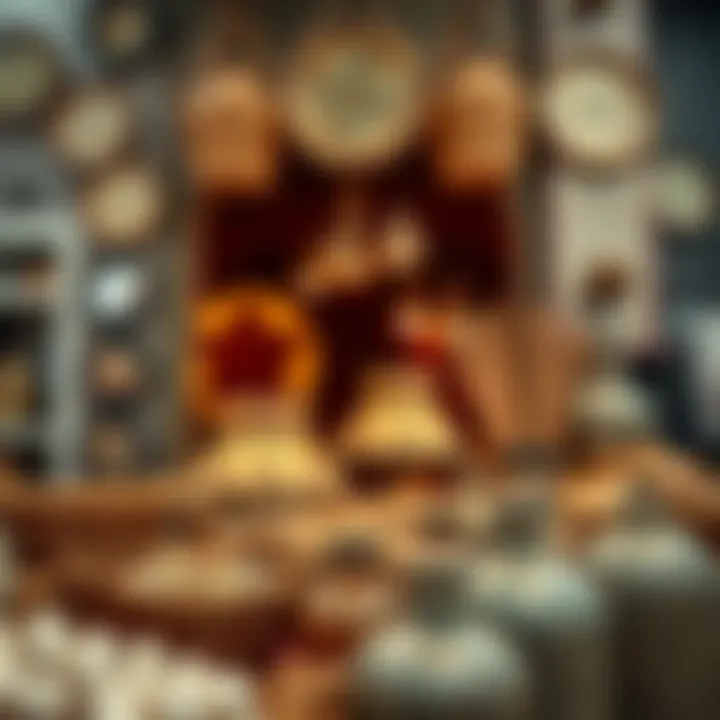Discovering Al Nad Al Shiba Markets: A Detailed Guide


Intro
The Al Nad Al Shiba markets stand as a vibrant tapestry in the shopping landscape of Dubai. Rooted in both tradition and modernity, they offer a blend of experiences that appeal to a wide array of consumers, from residents to tourists. Understanding these markets requires more than just a glimpse at the surface; it demands an exploration of their historical context, cultural significance, and their economic implications on Dubai's bustling environment.
This guide not only seeks to highlight the various elements that make Al Nad Al Shiba distinct, but it also aims to provide readers with an incisive perspective on how these markets fit into Dubai's larger narrative. What trends are shaping the preferences of consumers? How does this reflect on investment opportunities? The interplay of these factors delineates the character of the markets and underscores their relevance in today's fast-paced commerce.
As we delve into the subsequent sections, we will unpack the layers of insight that define the Al Nad Al Shiba markets, ultimately providing a comprehensive understanding that benefits potential investors, local businesses, and lifestyle enthusiasts alike.
Historical Context of Al Nad Al Shiba Markets
Understanding the historical context of Al Nad Al Shiba markets is crucial for grasping their evolution and significance in Dubai’s societal fabric. The markets are not merely commercial hubs; they embody a rich tapestry of cultural exchange and economic vitality that illustrates Dubai’s transformation from a modest trading post to a bustling cosmopolitan center.
Historically, the ambiance of Al Nad Al Shiba has mirrored the larger narrative of Dubai—reflecting its journey toward modernization while still holding on to its heritage. Recognizing how these markets have adapted over time helps investors, homebuyers, and property managers appreciate their potential value in the landscape of Dubai’s economy.
Origins and Evolution
The origins of Al Nad Al Shiba markets trace back to the early 20th century when Dubai was primarily known for its pearling and trade in spices. With the discovery of oil in the 1960s, the city saw an influx of wealth and modernization, which significantly influenced the local market scene.
The markets began as simple, open-air stalls where local traders showcased their goods—everything from traditional textiles to spices. However, as global trade routes expanded, so did these markets. Renovations and restructuring in the late 1990s laid the groundwork for what we see today—a more organized and diverse marketplace. The construction boom after the turn of the century further accelerated growth, integrating modern retail concepts while conserving elements of traditional market culture.
Cultural Influences Over Time
Cultural influences have played a pivotal role in shaping the identity of Al Nad Al Shiba markets. Initially, the market's character was deeply interwoven with the heritage of the Emirati people. However, as Dubai became a melting pot attracting expats from various backgrounds, a blend of cultures started to seep into the marketplace.
This cross-pollination of ideas and products has given rise to a unique shopping experience. For instance, you will find everything from locally crafted souvenirs to modern fashion brands, showcasing the evolving taste of the consumer base. Festivals, art exhibitions, and food fairs held in the vicinity celebrate this cultural mosaic, drawing locals and tourists alike into shared experiences that foster community.
As a result, Al Nad Al Shiba has become more than just a market; it represents a space where traditions meet modernity, and cultures converge, making it a vital aspect of Dubai’s social and economic narrative.
"The true essence of the Al Nad Al Shiba markets lies not just in the exchange of goods but in the stories and cultures interwoven within its stalls."
In this light, it's evident that understanding the historical context of Al Nad Al Shiba markets is essential for stakeholders looking to engage with this vibrant community. The evolution from humble beginnings to a bustling commercial marketplace reflects broader economic shifts, while cultural influences highlight the unique character that continues to attract an array of visitors and investors alike.
Market Structure and Layout
The Market Structure and Layout is crucial to understanding the dynamics of the Al Nad Al Shiba markets. This section not only describes the physical design of the markets but also reveals how these structures cater to the diverse needs of shoppers and enhance the overall shopping experience. For investors, homebuyers, and property managers, grasping the layout and organization of retail outlets helps identify the potential for growth and strategy in this vibrant market.
Types of Retail Outlets
In Al Nad Al Shiba markets, you'll find a medley of retail outlets that reflect both the local culture and international trends. The variety ranges from small artisanal shops that sell handmade crafts to global franchise stores that cater to popular consumer brands.
- Artisan Shops: These are typically run by local craftsmen, selling everything from intricate jewelry to handcrafted pottery. The personal touch and unique products offered in these shops draw in a clientele looking for authenticity.
- Franchise Stores: Big names like Carrefour and Starbucks have also found their way into the market, appealing to a broader audience. These retailers provide convenience and familiarity, often ensuring steady foot traffic.
- Pop-up Stores: Adding to the market's vibrancy, pop-up stores frequently appear in various corners of Al Nad Al Shiba. They showcase a rotating selection of products, keeping the shopping experience fresh and exciting.
The mix of these different types of outlets creates a dynamic ecosystem. Shoppers enjoy the variety, which encourages longer visits and potentially higher spending.
Spatial Configuration and Design
The spatial configuration and design of Al Nad Al Shiba markets play a pivotal role in shaping shopper behavior. The layout is deliberately organized to facilitate both ease of movement and an immersive shopping experience. Vendors often create attractive displays, luring passersby with eye-catching merchandise.
Flow and Accessibility
- The market is laid out in a way that promotes natural flow. Wide corridors allow for easy navigation, accommodating large crowds, especially during peak shopping times. The strategic placement of high-demand stores near entrances cultivates engagement.
- Accessibility is another consideration. Parking facilities nearby and connections to public transport ensure that shoppers can easily reach the market. A well-designed layout shows intelligence behind shopper convenience, appealing not only to occasional visitors but regulars familiar with the market’s flow.
Ambience and Experience
- The design also contributes to the ambiance of the market. Many retail spaces incorporate local architectural elements, creating a sense of belonging and pride. This cultural aesthetic enhances the shopping experience by infusing a local flavor that resonates with both residents and tourists.
- Additionally, open spaces are often used creatively; seating areas, fountains, and greenery provide a tranquil break from shopping chaos, allowing customers to recharge.
The thoughtful layout and structure of Al Nad Al Shiba markets not only improve shopper satisfaction but also significantly contribute to the overall economic vitality of the area.


Understanding the elements of Market Structure and Layout equips investors with insights into the Al Nad Al Shiba markets' potential growth, making them an attractive proposition within Dubai�’s diverse commercial landscape.
Demographics of Shoppers
Understanding the demographics of shoppers at Al Nad Al Shiba markets is crucial for grasping the varied fabric of this vibrant community. These markets are not just points of transaction; they represent a cross-section of cultural influences, economic interactions, and social exchanges. The shoppers' profiles in these markets offer valuable insight into consumer trends, preferences, and behaviors that can significantly affect market dynamics.
Cultural Diversity Among Shoppers
Al Nad Al Shiba markets draw a melting pot of visitors from diverse cultural backgrounds. The blend of local Emiratis, expatriates, and tourists creates a unique atmosphere that can feel like a bazaar—a lively mix of traditions and customs all converging into one bustling space. This diversity influences everything from the types of products available to the marketing strategies employed by vendors.
For instance, stalls selling traditional Arabic attire brush shoulders with kiosks offering Western brands, catering to a wide array of tastes. This cultural mosaic means vendors must be astute in understanding their clientele. Knowledge of different preferences helps them curate their offerings, which ultimately boosts sales and satisfaction.
In a tangible way, the market showcases elements of global culture, with food stalls featuring an assortment of cuisines from Indian curry to Italian gelato. This rich tapestry not just enhances the shopping experience but also encourages a warm, communal vibe. People engage in conversations about their origins, often swapping recipes or tips about local lifestyles, thus enriching the shopping experience with cultural exchange.
Trends in Consumer Behavior
The trends exhibited by consumers in Al Nad Al Shiba reflect broader shifts in shopping habits, particularly in the wake of advances in technology and changes in social preferences. One noticeable trend is the growing inclination towards sustainable and local products. Consumers are becoming increasingly aware of their purchasing impacts and tend to support local artisans and businesses. In this market, stalls that offer handmade goods or environmentally friendly products often see a surge in foot traffic.
Additionally, the rise of tech-savvy shoppers has not gone unnoticed. With smartphones in hand, many consumers compare prices, seek out reviews, and navigate through digital promotions while browsing. Market vendors who adapt by offering digital payment solutions or loyalty rewards can capture this audience effectively.
The fusion of traditional shopping experiences with modern consumer expectations reflects a broader movement towards creating spaces that resonate with today’s shopper. It is not simply about buying goods anymore; it’s about fulfilling a lifestyle and aligning personal values with purchasing decisions.
"Understanding who shops here provides key insights into how the market operates and evolves, like a living organism adapting to its environment."
Understanding the demographics of shoppers at Al Nad Al Shiba markets not only aids vendors in targeting their customers effectively but also enriches the overall market experience, making it not just a destination for shopping but a thriving community hub.
Types of Offerings in Al Nad Al Shiba Markets
When stepping into the Al Nad Al Shiba markets, one quickly notices the rich tapestry of offerings available. This section is pivotal for understanding how these markets serve not only as shopping venues but also as cultural enclaves that showcase both local and international flavors. The breadth of products available reflects the diverse population that frequents these markets, enhancing their significance in the broader economic context of Dubai.
Local Products and Artisanal Goods
The local products found in Al Nad Al Shiba markets represent a treasure trove of the heritage and artistry unique to the region. From handmade textiles to intricate pottery, these goods are often crafted by skilled artisans who pour their heart and soul into their work.
For instance, consider the handmade Dallah coffee pots, which are not just functional, but represent a vital aspect of Emirati hospitality tradition. Shoppers can witness the craftsmanship that goes into creating these items, often engaging with the makers themselves, which builds a sense of connection and community.
In addition to tangible products, the markets also offer local spices and herbs, integral to Emirati cuisine. The aromatic smells wafting through the stalls entice passersby, drawing them in to explore. Many visitors appreciate the chance to sample traditional foods made from these ingredients, further enriching their experience. Beyond providing a platform for local craftspeople, the sale of these goods contributes significantly to the local economy.
- Benefits of local offerings:
- Support for local artisans and small businesses
- Preservation of cultural crafts
- Unique gifts that embody authentic local flavors
Shoppers at the Al Nad Al Shiba markets leave not only with purchases, but often with stories and experiences, ensuring that the spirit of the locality thrives through each transaction.
International Brands and Franchises
While local products hold a dear place in the heart of Al Nad Al Shiba markets, the presence of international brands and franchises adds another layer of diversity to the shopping landscape. This blend allows residents and visitors alike to indulge in familiar global favorites while still enjoying the unique atmosphere of the markets.
Big names like Nike and H&M attract a diverse clientele, presenting shoppers with options that may be lacking in other retail spaces. For many expatriates living in Dubai, these brands provide a slice of home, while tourists appreciate the ease of access to globally recognized products.
Moreover, the juxtaposition of international brands with local offerings creates a unique shopping experience. A visitor could purchase a luxurious French perfume right next to a handcrafted Bahraini rug, fully embodying the cosmopolitan nature of Dubai.
- Positive aspects of international offerings:
- Wider range of products catering to diverse tastes
- Economic benefits through job creation and brand investments
- Integration of global trends with local market dynamics
Ultimately, the types of offerings in Al Nad Al Shiba markets are vital to its identity. They not only provide consumers with an eclectic mix of products but also support the broader narrative of Dubai as a melting pot of cultures and commerce.
The Role of Al Nad Al Shiba in Local Economy


Al Nad Al Shiba markets serve as a crucial component of the Dubai economy, acting as a catalyst for local commerce and employment. Understanding their role goes beyond just looking at the physical goods on display; it’s about grasping how these markets influence the livelihood of residents and the broader economic landscape. As these markets flourish, they foster not only economic activity but also social interactions and cultural exchanges which are essential for a vibrant community. The interconnectivity between the people and the markets strengthens neighborhood ties and boosts economic resilience in the face of fluctuating market demands.
Contribution to Employment
The employment opportunities generated by Al Nad Al Shiba markets are significant, providing jobs to a diverse mix of people, including local workers and expatriates. These markets are not just retail destinations but hubs that encompass various sectors from retail and hospitality to logistics and management. Small enterprises flourish here, creating jobs in both direct and ancillary roles.
- Retail Staff: Vendors often require positions such as cashiers, sales associates, and stall managers, leading to a range of employment options for job seekers.
- Support Roles: Beyond direct sales roles, there are jobs in areas such as security, maintenance, and cleaning which contribute to the operational efficacy of the markets.
- Training Programs: Many businesses in these markets are invested in the local workforce, providing training programs that enhance skillsets and empower residents.
"Al Nad Al Shiba markets not only provide a place to shop but also play a pivotal role in creating sustainable employment for the local population, making economic self-sufficiency a closer reality for many individuals."
Such opportunities are particularly beneficial in creating a workforce that is trained and ready for various aspects of the Dubai economy. As Al Nad Al Shiba continues to thrive, the local labor market also becomes more robust and dynamic, leading to an overall uplift in the neighborhood economy.
Impact on Local Commerce
The economic activity surrounding Al Nad Al Shiba markets is essential, fueling local commerce in more ways than one. These markets act as a platform for local artisans and entrepreneurs to showcase their products. The ripple effect of this is felt across various sectors.
- Boosting Local Businesses: Small businesses often benefit from being part of the market ecosystem which attracts a steady flow of customers. This foot traffic translates into sales, which in turn enhances profitability and sustainability for these businesses.
- Attracting Tourism: The unique offerings and experiences available at Al Nad Al Shiba markets draw tourists, enhancing the visibility and credibility of local brands. This not only benefits the markets but fortifies Dubai’s image as a vibrant shopping destination.
- Contribution to the Economy: Every transaction made within the markets contributes to the local tax base, which in turn supports public services and infrastructure projects in the area.
In summary, Al Nad Al Shiba markets are pivotal in propelling local commerce forward. They provide a vital platform for businesses while also generating jobs and contributing to the overall economic health of the region. As these markets evolve, their impact on the local economy will continue to grow.
Strategic Location and Accessibility
The strategic location of Al Nad Al Shiba markets plays a critical role in its success and sustainability within the competitive retail landscape of Dubai. Situated conveniently between key residential zones and major road networks, these markets serve not only as shopping destinations but as central hubs for social interaction and community engagement. The geographical positioning influences both accessibility for local residents and attraction for visitors from other areas, making it essential to explore its transport links and the resulting foot traffic.
Transport Links to the Area
Getting to Al Nad Al Shiba markets is relatively easy, thanks to a well-developed transportation network. Major highways such as Sheikh Mohammed Bin Zayed Road facilitate smooth vehicular access, ensuring that shoppers can arrive without undue hassle. Furthermore, public transportation options like buses and the metro make it accessible for those who prefer not to drive. The proximity to the Dubai International Airport also enhances its appeal, as travelers seeking local shopping experiences can easily venture to the markets post-flight.
- Bus Routes: Numerous buses pass by and stop near the markets, providing a budget-friendly option for many. Regular services connect residents from various parts of the city directly to Al Nad Al Shiba.
- Metro Connectivity: While there’s no direct metro station at the markets, the nearby stations are just a short taxi ride away, increasing overall accessibility.
- Parking Facilities: Ample parking space is available which is a boon for those driving in. This is a crucial aspect, particularly during peak shopping hours or weekends, where the demand for parking can spike.
The integration of these transport options fosters a steady influx of visitors, keeping the markets lively and vibrant.
Foot Traffic and Visitor Statistics
Analyzing foot traffic and visitor statistics provides valuable insight into the dynamics at play within Al Nad Al Shiba markets. On average, the markets see thousands of visitors each week, and while numbers fluctuate with seasonal trends, a general uptick is noted during festive periods.
"Foot traffic in Al Nad Al Shiba markets has increased by 20% over the last couple of years, highlighting its growing importance in the local retail landscape."
- Peak Times: Typically, weekends draw the largest crowds as families and shoppers flock to the markets for leisure and shopping. Conversely, weekdays might see a more subdued atmosphere, yet the foot traffic remains consistent due to local workers and residents.
- Visitor Demographics: It’s diverse, ranging from local Emirates to expatriates and tourists. This mix enriches the shopping environment, turning it into a melting pot of cultures where various preferences and needs converge.
- Impact on Sales: Higher foot traffic correlates with increased sales volume, compelling vendors to optimize their offerings to cater to the tastes and expectations of a varied clientele.
Challenges Facing Al Nad Al Shiba Markets
The retail landscape can be as tough as a two-dollar steak, and Al Nad Al Shiba markets face a host of challenges that can impact their appeal and financial stability. Understanding these hurdles is crucial for anyone looking to invest, manage properties, or even simply appreciate the local shopping scene.
Competition from Other Shopping Destinations
In the bustling hub of Dubai, competition is fierce. Al Nad Al Shiba markets are not operating in a vacuum; they have to contend with established giants like The Dubai Mall and Mall of the Emirates. These larger centers boast extensive facilities, luxury brands, and unique experiences that draw in both tourists and residents alike.
- Brand Popularity: Well-known brands often prefer high-traffic areas where footfall is practically guaranteed. Some local stores find it hard to compete when shoppers prefer glitzy brands.
- Diverse Offerings: Larger malls offer entertainment and dining options that Al Nad Al Shiba markets may lack. Shoppers could be enticed by cinemas or fine dining, leading them to other destinations.
- Promotions and Marketing: It’s a marketing jungle out there. Competing malls run extensive marketing campaigns to capture consumer interest, making it a challenge for smaller markets like Al Nad Al Shiba to carve out their niche.
As buyers often seek convenience alongside variety, the need for Al Nad Al Shiba markets to adapt their strategies becomes increasingly critical.
Economic Fluctuations and Their Impact
Economic conditions fluctuate like a seesaw, affecting consumer spending habits drastically. Al Nad Al Shiba markets are particularly sensitive to these changes.
- Consumer Behavior: In times of economic uncertainty, shoppers tighten their belts. Non-essential purchases take a backseat, which can directly affect the sales of local retailers. People often opt for necessities over luxury items, forcing markets to rethink their inventory.
- Supply Chain Issues: Global economic shifts can impact imports, leading to inventory shortages. Retailers might struggle to stock popular items or might have to raise prices due to increased costs, shying away potential customers.
- Investment Climate: Investors are often wary of markets that seem volatile or under threat from competition. If economic indicators aren't looking good, attracting new businesses or investments becomes a tall order.
"In retail, survival is often a matter of adaptation and foresight; being aware of market shifts can set one apart from the crowd."


For more insights on Dubai's economic climate, check resources like Dubai Economic Council and UAE's Federal Competitiveness and Statistics Authority.
Community Engagement and Events
Community engagement within the Al Nad Al Shiba markets serves as a vital linchpin, connecting the neighborhood with a rich tapestry of culture and tradition. Events and activities create a vibrant atmosphere, encouraging interaction among locals and visitors alike. This engagement is more than just a social exercise; it's instrumental in promoting a sense of belonging. The markets become a hub where people gather, share experiences, and foster relationships.
Festivals and Cultural Events
Festivals play a majestic role in highlighting the diverse cultural fabric of Al Nad Al Shiba markets. Throughout the year, local festivities abound, reflecting both traditional and contemporary influences.
- Diwali Celebrations: The festival of lights draws in large crowds, with stalls offering festive items, sweets, and decorations that embody the spirit of the celebration.
- Eid Fairs: These gatherings promote community spirit, featuring activities such as henna painting, traditional music, and local cuisine, which together create an atmosphere of joy and festivity.
- Heritage Days: Events focused on cultural heritage allow local artisans to showcase their crafts and practices, nurturing a sense of pride within the community.
Such celebrations foster a communal identity, while also attracting visitors who wish to partake in the local culture. These engagements often lead to economic benefits, as increased foot traffic translates into enhanced sales for merchants.
Promotions and Discounts
Promotions and discounts in Al Nad Al Shiba markets serve as potent tools for not only boosting sales but also encouraging community participation. Seasonal discounts can attract shoppers, especially during peak times such as holidays or festivals.
- Community Loyalty Programs: Many vendors implement loyalty programs that reward repeat customers with special offers, fostering long-term relationships with the clientele.
- Collaboration with Local Businesses: Joint promotions between various vendors amplify their visibility and help to capture a broader audience, creating a win-win situation.
- Flash Sales: These short-term promotions create urgency, often resulting in increased sales, and encourage spontaneous visits to the market.
Promotional activities are effective avenues that enhance the shopping experience while also solidifying the markets' reputation as a destination for quality and value.
"Community events are at the heart of the Al Nad Al Shiba markets, nourishing not only the local economy but also the social fabric of the community."
In essence, the blend of festivals, cultural events, and strategic promotions creates a dynamic environment that resonates with both residents and visitors. By fostering a culture of inclusivity and engagement, Al Nad Al Shiba markets become more than just retail spaces; they evolve into essential social arenas where culture and commerce intertwine.
Future Prospects of Al Nad Al Shiba Markets
The future of Al Nad Al Shiba markets holds a lot of promise. With Dubai’s rapid growth, there are clear indicators that this market will continue to evolve, adapting to shifts in consumer preferences, technological advancements, and the overall economic landscape. For investors and stakeholders, understanding these future prospects is essential for making informed decisions about potential opportunities that lie ahead.
Potential for Expansion and Development
Expansion and development opportunities in Al Nad Al Shiba markets are noteworthy. The area has already shown signs of growth with plans to upgrade infrastructure and enhance the shopping experience. This process can take several forms:
- New Retail Outlets: The addition of vibrant shops, potentially featuring a mix of local artisans and international brands, will cater to a wider audience.
- Enhanced Amenities: As customer expectations evolve, investing in amenities such as improved parking facilities, food courts, and entertainment options could significantly enhance visitor experiences.
- Sustainability Practices: Emphasizing eco-friendly practices in market operations may draw in a more conscientious shopper demographic. This can include using sustainable materials for shop fittings and reducing waste through clever recycling programs.
Such expansion not only boosts local employment but also adds to the market’s appeal for tourists keen on experiencing the local lifestyle.
Adaptation to Global Trends
Adapting to global trends is crucial for any market wishing to thrive, and Al Nad Al Shiba is no exception. The following trends are already shaping the direction of these markets:
- Digital Transformation: The recent surge in online shopping cannot be ignored. Local markets are starting to explore e-commerce integration, enabling vendors to reach customers beyond geographical limitations. It’s about striking a balance between physical and digital shopping experiences.
- Health and Wellness: Rising global interest in health-conscious products means that farmers’ markets or health food stalls could become more prominent. Shoppers are increasingly seeking fresh, organic, and locally sourced products.
- Cultural Integration: With Dubai being a melting pot of cultures, incorporating diverse cultural festivals and events in market programming could enrich visitor engagement and broaden the market's appeal.
The Al Nad Al Shiba markets stand at a crossroads, facing the need to adapt while also accommodating the unique tastes of their patrons. Investors need to keep an eye on these shifting dynamics as they signal how the market might grow in the coming years.
Ending: The Significance of Al Nad Al Shiba Markets
The Al Nad Al Shiba markets are not just mere shopping spots; they embody the pulse of the community in Dubai. This conclusion draws together the many threads that illustrate why these markets matter significantly in the broader narrative of the city's economic and cultural tapestry.
Summary of Key Insights
Delving deeper, several pivotal insights emerge that encapsulate the essence of the Al Nad Al Shiba markets:
- Cultural Hub: The markets serve as a melting pot of cultures, showcasing local traditions while also embracing global influences. They offer a unique blend of products that reflect both the heritage and modernity of Dubai.
- Economic Driver: These markets play a vital role in bolstering the local economy. They provide essential job opportunities and stimulate the commerce sector, making them integral to Dubai's economic landscape.
- Community Engagement: The markets act as a gathering point for social and cultural interactions. They host various festivals and events, fostering a sense of community and belonging among residents.
- Consumer Behavior Trends: Insightful patterns in consumer behavior reveal a growing preference for local products and artisanal goods. This shift emphasizes a move towards sustainability and community support.
"Shopping in Al Nad Al Shiba is more than a transaction; it’s an immersive experience that connects people to their roots and to each other."
The Future Landscape of the Markets
Looking ahead, the Al Nad Al Shiba markets appear poised for further growth and transformation. Several factors will shape their trajectory:
- Potential for Expansion and Development: As Dubai evolves, so too will the markets. Plans for expansion may see new retail spaces and attractions that could enhance the shopper experience and keep the area dynamic.
- Adaptation to Global Trends: With the world leaning toward eco-friendliness and sustainable practices, these markets may need to adapt. Embracing green initiatives and focusing on organic products might hold appeal for future consumers.
- Continued Cultural Relevance: As Dubai furthers its appreciation for heritage, the markets are likely to increasingly fuse contemporary designs with traditional architecture, setting a stage for a vibrant yet grounded retail atmosphere.
In summary, the future of Al Nad Al Shiba markets is rich with opportunity, whose relevance in Dubai's landscape will only grow as they adapt and respond to both local and global trends. This synthesis of cultural significance and economic contribution positions them as not merely shopping locations but as vital community engines that represent the heart of Dubai.















